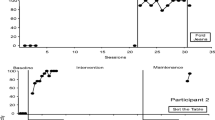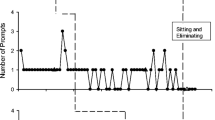Abstract
The aim of the study was to investigate the effectiveness of an animation-based teaching package on the acquisition of three daily living skills based on the performance of three middle school students with mild or moderate intellectual disability. An animation-based teaching package was designed to include explicit instructional procedures and was developed and tested by the researchers within the scope of the study in order to meet the specific needs of the target group. A multiple probe across behaviors design was applied for this single-subject research in order to investigate the effect of an animation-based daily life skills teaching package on the learning of culinary skills by three middle school students with ID. The culinary skills were sandwich preparation, brewing tea, and pouring tea. The participants in the study showed overall improvement in their task performance following the intervention. The results revealed animation-based video modeling to be an effective method in improving the acquisition of daily living skills. Animation-based teaching may be used as a means to teach effective daily living skills to students with ID.





Similar content being viewed by others
Data availability
The datasets generated during and/or analysed during the current study are available from the corresponding author on reasonable request.
References
Ayres, K., & Cihak, D. (2010). Computer- and video-based instruction of food-preparation skills: Acquisition, generalization, and maintenance. Intellectual and Developmental Disabilities, 48(3), 195–208. https://doi.org/10.1352/1944-7558-48.3.195
Barak, M., & Dori, Y. J. (2009). Enhancing higher order thinking skills among inservice science teachers via embedded assessment. Journal of Science Teacher Education, 20(5), 459–474. https://doi.org/10.1007/s10972-009-9141-z
Bellini, S., & Akullian, J. (2007). A meta-analysis of video modeling and video self-modeling interventions for children and adolescents with autism spectrum disorders. Exceptional children, 73(3), 264–287. https://doi.org/10.1177/001440290707300301
Bouck, E. C. (2010). Reports of life skills training for students with intellectual disabilities in and out of school. Journal of Intellectual Disability Research, 54(12), 1093–1103. https://doi.org/10.1111/j.1365-2788.2010.01339.x
Bouck, E. C., Satsangi, R., & Bartlett, W. (2016). Comparing a number line and audio prompts in supporting price comparison by students with intellectual disability. Research in Developmental Disabilities, 53–54, 342–357. https://doi.org/10.1016/j.ridd.2016.02.011
Browder, D. M., & Spooner, F. (2011). Teaching students with moderate and severe disabilities. Guilford.
Burns, C. O., Lemon, J., Granpeesheh, D., & Dixon, D. R. (2019). Interventions for daily living skills in individuals with intellectual disability: A 50-year systematic review. Advances in Neurodevelopmental Disorders, 3(3), 235–245. https://doi.org/10.1007/s41252-019-00114-0
Cakmak, S., & Cakmak, S. (2015). Teaching to intellectual disability individuals the shopping skill through ipad. European Journal of Educational Research, 4(4), 177–183. https://doi.org/10.12973/eu-jer.4.4.177
Cannella-Malone, H. I., Brooks, D. G., & Tullis, C. A. (2013). Using self-directed video prompting to teach students with intellectual disabilities. Journal of Behavioral Education, 22, 169–189. https://doi.org/10.1007/s10864-013-9175-3
Charlton, C. T., Kellems, R. O., Black, B., Bussey, H. C., Ferguson, R., Goncalves, B., & Vallejo, S. (2020). Effectiveness of avatar-delivered instruction on social initiations by children with autism spectrum disorder. Research in Autism Spectrum Disorder, 71, 101494.
Chiu, Y. L., Wu, W. G., Kang, Y. F., Kang, Y. S., & Chang, Y. J. (2019). Using a Motion-controlled Game to Teach Four Elementary School Children with Intellectual Disabilities to Improve Purchasing Skills. Journal of Computers, 30(5), 227–236. https://doi.org/10.3966/199115992019103005018
Collins, B. C. (2012). Systematic instruction for students with moderate to severe disabilities. Brookes.
Cullen, J. M., Simmons-Reed, E. A., & Weaver, L. (2017). Using 21st century video prompting technology to facilitate the independence of individuals with intellectual and developmental disabilities. Psychology in the Schools, 54(9), 965–978. https://doi.org/10.1002/pits.22056
Drysdale, B., Lee, C. Y. Q., Anderson, A., & Moore, D. W. (2015). Using video modeling incorporating animation to teach toileting to two children with autism spectrum disorder. Journal of Developmental and Physical Disabilities, 27, 149–165. https://doi.org/10.1007/s10882-014-9405-1
EldenizÇetin, M., & Geçal, İ. (2017). Zihinsel yetersizliği olan öğrencilerle çalışan öğretmenlerin eğitimde teknoloji kullanımına yönelik görüşleri ve önerilerinin belirlenmesi [Determination of Opinions and Recommendations For The Use of Technology in Education Teachers Working With Students With Intellectual Disabilities]. Akademik Sosyal Araştırmalar Dergisi, 5(52), 624–635.
Fujisawa, K., Inoue, T., Yamana, Y., & Hayashi, H. (2011). The effect of animation on learning action symbols by individuals with intellectual disabilities. Augmentative and Alternative Communication, 27(1), 53–60. https://doi.org/10.3109/07434618.2011.553245
Gast, D. L. (2010). Single subject research methodology in behavioral sciences. Routledge.
Gast, D. L., & Spriggs, A. (2010). Visual analysis of graphic data. In D. L. Gast (Ed.), Single subject research methodology in behavioral sciences (pp. 199–233). Routledge.
Gilson, C. B., Carter, E. W., & Biggs, E. E. (2017). Systematic review of instructional methods to teach employment skills to secondary students with intellectual and developmental disabilities. Research and Practice for Persons with Severe Disabilities, 42(2), 89–107. https://doi.org/10.1177/2F1540796917698831
Goo, M., Maurer, A. L., Wehmeyer, M. L. (2019). Systematic review of using portable smart devices to teach functional skills to students with intellectual disability. Education and Training in Autism and Developmental Disabilities, 54(1), 57–68. Retrieved October 23, 2022, from https://www.jstor.org/stable/26663962
Hicks, S. C., Rivera, C. J., & Wood, C. L. (2015). Using direct instruction: Teaching preposition use to students with intellectual disability. Language, Speech, and Hearing Services in Schools, 46(3), 194–206. https://doi.org/10.1044/2015_LSHSS-14-0088
Individuals with Disabilities Improvement Education Act of 2004, Pub.L.No. 108–446, 20 U.S.C. 1400 et seq. (2004). Retrieved March 12, 2023, from https://www.govinfo.gov/content/pkg/PLAW-108publ446/pdf/PLAW-108publ446.pdf
Ivey, A. N., Mechling, L. C., & Spencer, G. P. (2015). Use of a proximity sensor switch for “Hands Free” operation of computer-Based video prompting by young adults with moderate intellectual disability. Education and Training in Autism and Developmental Disabilities, 50(3), 278–289. Retrieved August 8, 2022, from https://www.jstor.org/stable/24827510
Johnson, J. W., Blood, E., Freeman, A., & Simmons, K. (2013). Evaluating the effectiveness of teacher-implemented video prompting on an iPod Touch to teach food-preparation skills to high school students with autism spectrum disorders. Focus on Autism and Other Developmental Disabilities, 28(3), 147–158. https://doi.org/10.1177/1088357613476344
Kang, Y.-S., Chang, Y.-J., & Howell, S. R. (2021). Using a kinect-based game to teach oral hygiene in four elementary students with intellectual disabilities. Journal of Applied Research in Intellectual Disabilities, 34(2), 606–614. https://doi.org/10.1111/jar.12828
Kellems, R. O., Charlton, C., Kversøy, K. S., & Győri, M. (2020). Exploring the use of virtual characters (avatars), live animation, and augmented reality to teach social skills to individuals with autism. Multimodal Technologies and Interaction, 4(3), 48. https://doi.org/10.3390/mti4030048
Lopez, A. F., Fortiz, M. J. R., & Garcia, M. N. (2009). Designing and supporting cooperative and ubiquitous learning systems for people with special needs. In R. Meersman, P. Herrero, & T. Dillon (Eds.), On the Move to Meaningful Internet Systems: OTM 2009 Workshops, LNCS 5872 (pp. 423–432). Springer.
Luzón, J. M., & Letón, E. (2015). Use of animated text to improve the learning of basic mathematics. Computers & Education, 88, 119–128. https://doi.org/10.1016/j.compedu.2015.04.016
McMahon, D. D., Smith, C. C., Cihak, D. F., Wright, R., & Gibbons, M. M. (2015). Effects of digital navigation aids on adults with intellectual disabilities: Comparison of paper map, google maps, and augmented reality. Journal of Special Education Technology, 30(3), 157–165. https://doi.org/10.1177/0162643415618927
Mechling, L.C. (2007). Assistive technology as a self-management tool for prompting students with intellectual disabilities to initiate and complete daily tasks: A literature review. Education and Training in Developmental Disabilities, 42(3), 252–269. Retrieved August 8, 2022, from https://www.jstor.org/stable/23879621
Ministry of National Education (2018). Regulation of special education services. Retrieved April 10, 2023, from https://www.resmigazete.gov.tr/eskiler/2018/07/20180707-8.htm
Ohtake, Y., Takahashi, A., & Watanabe, K. (2015). Using an animated cartoon hero in video instruction to improve bathroom-related skills of a student with autism spectrum disorder. Education and Training in Autism and Developmental Disabilities, 50(3), 343–355.
Ramdoss, S., Lang, R., Fragale, C., Britt, C., O’Reilly, M., Sigafoos, J., Didden, R., Palmen, A., & Lancioni, G. E. (2012). Use of computer-based interventions to promote daily living skills in individuals with intellectual disabilities: A systematic review. Journal of Developmental and Physical Disabilities, 24(2), 197–215. https://doi.org/10.1007/s10882-011-9259-8
Rezaiyan, A., Mohammadi, E., & Fallah, P. A. (2007). Effect of computer game intervention on the attention capacity of mentally retarded children. International Journal of Nursing Practice, 13(5), 284–288. https://doi.org/10.1111/j.1440-172X.2007.00639.x
Scott, R., Collins, B., Knight, V., & Kleinert, H. (2013). Teaching adults with moderate intellectual disability ATM use via the iPod. Education and Training in Autism and Developmental Disabilities, 48(2), 190–199. Retrieved January 1, 2023, from https://www.jstor.org/stable/23880639
Shepherd, A. (2012). The case of Drew: An animated social narrative intervention to improve the social skills of a student with a mild intellectual disability (MID). Journal of Student Engagement: Education Matters, 2(1), 65–77. Retrieved April 25, 2022, from https://ro.uow.edu.au/jseem/vol2/iss1/12/
Smith, C. C., Cihak, D. F., Kim, B., McMahon, D. D., & Wright, R. (2017). Examining augmented reality to improve navigation skills in post-secondary students with intellectual disability. Journal of Special Education Technology, 32(1), 3–11. https://doi.org/10.1177/0162643416681159
Smith, T. L., Polloway, E. A., Smith, J. D., & Patton, R. E. (2007). Self-determination for persons with developmental disabilities: Ethical considerations for teachers. Education & Training in Developmental Disabilities, 42(2), 144–151. Retrieved November 12, 2022, from https://www.jstor.org/stable/23879991
Taber-Doughty, T., Bouck, E. C., Tom, K., Jasper, A., Flanagan, S. M., & Bassette, L. (2011). Video modeling and prompting: A comparison of two strategies for teaching cooking skills to students with mild intellectual disabilities. Education and Training in Autism and Developmental Disabilities, 46(4), 499–513. Retrieved December 23, 2022, from https://www.jstor.org/stable/24232362
Varol, N. (2005). Beceri öğretimi ve öz bakım becerilerinin kazandırılması [Teaching skills and gaining self-care skills]. Kök Yayıncılık.
Wolf, M. M. (1978). Social validity: The case for subjective measurement or how applied behavior analysis is finding its heart. Journal of Applied Behavior Analysis, 11, 203–214.
Yeni, S., Cagiltay, K., & Karasu, N. (2020). Usability investigation of an educational mobile application for individuals with intellectual disabilities. Universal Access in the Information Society, 19(3), 619–632. https://doi.org/10.1007/s10209-019-00655-0
Funding
This work was supported by the Scientific and Technological Research Council of Turkey (TUBITAK) under Grant number 120K064.
Author information
Authors and Affiliations
Corresponding author
Ethics declarations
Ethical approval
All procedures performed in studies involving human participants were in accordance with the ethical standards of the institutional research committee and with the 1964 Helsinki declaration and its later amendments or comparable ethical standards.
Informed consent
Informed consent was obtained from the participants who participated in this study.
Conflict of interest
The authors declare that they have no conflict of interest.
Additional information
Publisher's note
Springer Nature remains neutral with regard to jurisdictional claims in published maps and institutional affiliations.
Rights and permissions
Springer Nature or its licensor (e.g. a society or other partner) holds exclusive rights to this article under a publishing agreement with the author(s) or other rightsholder(s); author self-archiving of the accepted manuscript version of this article is solely governed by the terms of such publishing agreement and applicable law.
About this article
Cite this article
Yalçın, G., Kocaöz, O.E. & Arslantas, T.K. Effectiveness of animation-based video modeling on daily living skills teaching to individuals with intellectual disabilities. Educ Inf Technol 28, 16233–16254 (2023). https://doi.org/10.1007/s10639-023-11863-w
Received:
Accepted:
Published:
Issue Date:
DOI: https://doi.org/10.1007/s10639-023-11863-w




